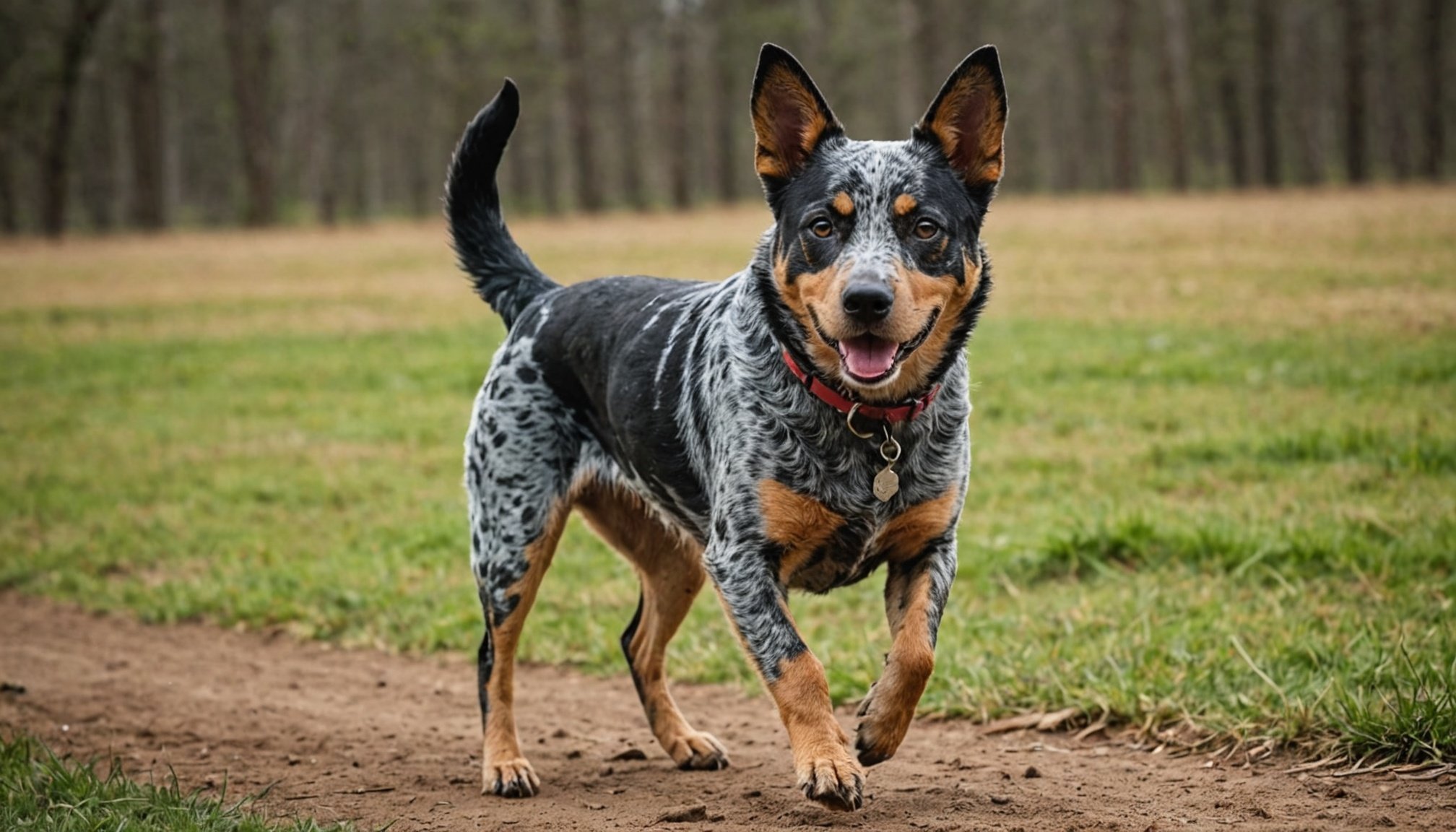Understanding the Exercise Needs of Australian Cattle Dogs
Australian Cattle Dogs, known for their boundless energy and intelligence, have distinctive exercise needs that make them unique. As energetic dogs, they thrive on physical challenges and require specific routines to keep them healthy and content. Due to their breeding history as herding dogs, they possess an inherent stamina and agility unmatched by many other breeds. This demands a structured exercise regimen tailored to their breed-specific requirements.
Regular physical activity is paramount for Australian Cattle Dogs to prevent health issues, such as obesity and mental stagnation. Activities like hiking, agility training, or even frisbee playing match their energetic dog’s needs, providing both mental and physical stimulation. Without sufficient exercise, these dogs may develop undesirable behaviors, a common issue among high-energy breeds.
A découvrir également : Boosting Bloodhound Scent Tracking Skills: Elevate Your Dog’s Performance in Search and Rescue Operations!
Behaviorally, Cattle Dogs might display restlessness or even destructive tendencies if their exercise needs are unmet. Such instincts stem from their working heritage, built on long days of herding. Owners must equip themselves with knowledge about these needs to foster a harmonious relationship with their pet.
In providing breed-appropriate exercises, Cattle Dogs not only maintain physical fitness but also harness their intelligence and satisfy their natural instincts, resulting in a well-rounded and fulfilled companion.
A découvrir également : Understanding the Ideal Vaccination Schedule for Your Belgian Malinois: Essential Tips for Pet Owners
Effective Exercise Routines for Australian Cattle Dogs
Australian Cattle Dogs are energetic and require well-planned exercise routines. Understanding the ideal activity levels can help in designing effective training schedules for these active pups.
Daily Exercise Recommendations
Daily exercise is essential to maintain their energy levels and keep them happy. It is typically recommended to provide at least 1 to 2 hours of physical activity each day. This can include a combination of walks, runs, and engaging games.
Types of Activities and Games
Engaging your dog in diverse activities prevents boredom and encourages proper development. Activities like agility practice, herding games, and playing fetch are ideal. These games not only utilize their natural instincts but also help improve obedience and coordination. Such varied exercise routines support both their physical and mental well-being.
Structuring Exercise Time
A well-structured exercise schedule can be tailored according to the dog’s age and energy levels. For example, puppies might benefit from shorter, more frequent sessions, while adult dogs can handle more intense activities. Ensuring a balanced routine that incorporates consistency is vital. Consistent schedules aid in managing energy levels, promoting better behavior, and strengthening the owner-dog bond.
Monitoring Techniques for Exercise
In today’s technologically advanced world, exercise monitoring has become an intuitive process designed to maximise health benefits through efficient activity tracking. Numerous tools and apps cater specifically to individuals eager to maintain and improve their physical health. Popular devices like smartwatches and fitness trackers provide real-time updates on calories burned, distance covered, and even heart rate fluctuations. These gadgets simplify the tracking process, enabling users to adjust their routines for optimum results.
Understanding the signs of adequate versus inadequate exercise is essential for a balanced workout regime. Adequate exercise usually results in a sense of increased energy levels and improved mood. Conversely, inadequate exercise may lead to fatigue without noticeable progress in strength or endurance. Monitoring these signs helps individuals adjust their fitness programs accordingly.
Heart rate and fatigue play significant roles in exercise monitoring. Maintaining an appropriate heart rate range during workouts ensures cardiovascular efficiency, promoting overall fitness. Fitness apps often include features to set and adjust heart rate targets based on individual fitness levels and goals. Recognising and respecting signals of fatigue is equally important to avoid overexertion.
Incorporating these monitoring techniques into a daily exercise routine not only supports effective physical activity tracking but also ensures that workouts contribute positively to one’s overall health journey.
Health Benefits of Regular Exercise
Engaging in consistent physical activity offers numerous health benefits that can significantly enhance quality of life. Regular exercise is a vital component for achieving optimal physical health, as it aids in weight management and improves muscle tone. Through various forms of exercise such as running, cycling, or strength training, individuals can maintain a healthy weight, which is crucial for preventing obesity-related diseases such as diabetes and heart conditions.
Beyond the physical advantages, exercise plays a critical role in mental stimulation. It has been shown to reduce boredom and anxiety, providing an excellent outlet for stress relief. When you engage in physical activity, your body releases endorphins, which act as natural mood lifters, thus improving your mental well-being.
Moreover, the impact of regular exercise extends beyond immediate benefits. Incorporating physical activity into your routine can lead to positive lifelong health outcomes. It has been linked to increased longevity and a reduced risk of chronic diseases, enhancing both physical and mental prowess over time. Activities that people can enjoy also foster social interaction and cognitive growth, contributing to a more fulfilled life. Embracing the habit early not only enriches one’s present but lays a foundation for a healthier future.
Training Tips for Managing Exercise
Mastering the art of dog training can be both challenging and rewarding. When paired with the right training tips, it becomes easier to reinforce desired behavior and establish obedience. Dogs thrive when they have a structured routine that includes regular exercise and training.
Combining Training with Exercise
Incorporating exercise into training sessions can greatly enhance the learning experience. While exercising, reinforce behavior such as “sit,” “stay,” or “come” to boost obedience. Use treats or verbal praise as immediate rewards, creating positive associations with following commands. This method not only exercises the body but stimulates the mind, fostering a well-rounded pet.
Encouraging Independent Play
Allowing your dog to explore and play independently is crucial for their development. Introduce toys that challenge and engage them, like puzzle feeders or fetch toys. These can promote problem-solving skills and reinforce behavior related to self-discipline and patience. Encourage independent play in a safe environment, ensuring the activity suits your dog’s energy level and size.
Socialization Opportunities
Socialization is essential for a well-adjusted dog. Utilize exercise time to introduce playdates with other dogs, which can reinforce behavior such as sharing and taking turns. Organize safe, controlled environments where your dog can meet peers and participate in group activities. This integration of socialization within exercise routines broadens your dog’s comfort in varied situations and improves their overall demeanor.
Dietary Considerations for Active Dogs
Meeting the nutritional needs of energetic dogs is crucial for maintaining their health and performance. These dogs frequently require a diet rich in proteins, fats, and carbohydrates that fuel their high activity levels. High-protein diets help in muscle repair and growth, while fats provide long-lasting energy. Incorporating quality carbohydrates supports sustained energy release during longer playtimes.
For dogs engaged in intense exercises, one crucial diet consideration is adjusting caloric intake to support activity without overweight risks. It’s advisable to consult with a veterinarian to tailor dietary adjustments based on the dog’s specific weight management needs. This can involve increasing or decreasing portion sizes and selecting more energy-dense or light options.
Hydration is equally important in diet considerations. Energetic dogs tend to lose significant amounts of water during workout periods. Ensuring proper hydration pre- and post-exercise prevents overheating and maintains optimal physiological functions. Offer frequent water breaks during activities and monitor your dog’s water intake closely, especially during hotter months or after vigorous play sessions.
In summary, understanding and implementing the right diet considerations for energetic dogs ensures these lively companions remain healthy and ready for their next adventure, whether it be a long hike or an extended play session in the park.
Practical Examples and Visual Aids
Aiding understanding with practical examples can significantly enhance engagement. For instance, case studies reveal how exercise monitoring transforms routines. One compelling example involves a middle-aged participant who tracked progress using a fitness watch. Initially doing moderate walks, she gradually incorporated brisk intervals, sharing her milestones at community events. This practical journey highlights how monitoring devices provide tangible feedback, fostering motivation through visible progress.
Visual aids, such as infographics, are invaluable for clarifying recommended exercise times and types. Infographics succinctly depict guidelines, like advising 150 minutes of moderate activity weekly. They visually segment options into daily walks, weekend hikes, or dance sessions, accommodating varied lifestyles. Such engaging imagery simplifies complex information, transforming guidelines into actionable steps.
Furthermore, videos demonstrating training techniques offer another layer of support. Watching experts execute activities like yoga poses or strength exercises clarifies execution details, from stances to breaths. These visual aids not only ensure safety but also inspire confidence in practitioners to try new exercises. Instructional videos effectively bridge the gap between theory and practice, making fitness accessible.
In conclusion, case studies and visual aids, IT’s crucial engaging tools in presenting practical information. They provide relatable examples and foster an informed exercise routine.










